Leslie Science Center Turns Calendar
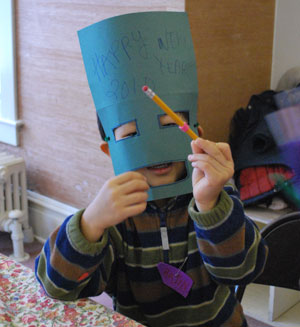
Hajin Kim, wearing his New Year's Eve mask, salutes the end of 2009 with a pencil. Later, he told The Chronicle: "Masks are scarier than hats." (Photos by the writer.)
Bob Voakes is sitting in the front room of the main Leslie Science and Nature Center building, encircled by more than a dozen children sprawled on the floor. “It’s a special day today – does anyone know what day it is?”
“New Year’s Eve!” they cry out.
It would be hard not to know the answer – everyone is wearing New Year’s Eve hats or masks that they’d made earlier that morning, using construction paper and markers.
They’re all enrolled in the holiday break camp program, with a full agenda of crafts, sledding, hiking, searching for animal tracks, s’more-making, and “who knows what other exciting things we might do!” Voakes, a staff member, tells the kids.
Just down the hall – in Dr. Eugene Leslie’s former study – someone else has a full agenda, too: executive director Kirsten Levinsohn, who’s getting ready to step down from the post in February, after 20 years at the center. With the sound of children happily hollering in the background, Levinsohn talked about the upcoming transition, and why it’s an exciting time for LSNC.
The Past All Around
Levinsohn’s office, like the entire complex of buildings on a hill overlooking Traver Road, still holds artifacts from the days when Eugene and Emily Leslie lived there: An old LC Smith Corona typewriter sits high on a shelf, just below more than a dozen faded green volumes of the Encyclopaedia Britannica. The Leslies moved to Ann Arbor from New York in the early 1920s, and set up a homestead that also served as a laboratory and workplace for Eugene Leslie, a University of Michigan professor and chemical engineer.
Childless, the Leslies both died in 1976 and bequeathed their property to the city of Ann Arbor. A decade later, the city developed a master plan for the site, with the goal of focusing on educational programs. The first year of operation, in 1990, 121 people participated in the center’s programs, Levinsohn says. This year, that number reached around 44,000.
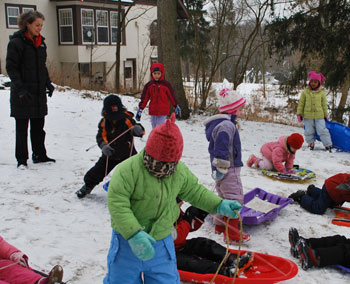
Kirsten Levinsohn, executive director of Leslie Science and Nature Center, watches as kids in the holiday break camp go sledding on Thursday.
Levinsohn was there from the beginning, starting out as part-time staff and working 10 hours a week. She was pregnant with her youngest son, Erik, and her eldest, Jonathan, was a toddler, so the schedule was a good fit.
Her job and its duties grew as her children did, she says, noting that her son Jonathan refers to the center as her third child. It’s a family-oriented place, both for its focus on programs for school-age children as well as the flexibility afforded its staff, many of whom have raised their own children with the center as an integral part of their lives.
By the time the center separated from the city in 2007 to become an independent nonprofit, Levinsohn had already been at the helm for several years.
Looking Ahead
The search committee for Levinsohn’s replacement has narrowed the field to five candidates, including two from this area. While in the past this type of organization would look for someone primarily with credentials as an environmentalist or naturalist, she says, today there’s a recognition that having professional management skills is important, too.
The executive director oversees a staff of five full-time employees, 10 part-timers and a coterie of volunteers. The center, which sits on about 50 acres of land, has a budget of roughly $500,000 – about half of that comes from program fees, like the $185 per child charge for this week’s four-day holiday break camp.
Support from the city of Ann Arbor accounts for about 6% of the total budget, or about $30,000. Although that annual funding is part of an agreement between the city and LSNC, this spring city administrator Roger Fraser had proposed cutting it from the city’s current fiscal year budget, as part of a broader effort to cut expenses from the general fund.
Supporters of the center protested, and city councilmembers ultimately passed budget amendments ensuring funding this year. The bulk of that funding was achieved by eliminating $24,000 previously allocated for historic district consulting. But the budget scenario is even grimmer for fiscal 2011, which begins July 1, 2010 – council will be making decisions about that budget by May. [See Chronicle coverage: "Ann Arbor City Budget: Cuts Begin Now"]
Public schools are another source of LSNC revenue that might be in jeopardy because of the current budget crisis. Schools programming accounts for $60-$70,000 annually. It’s also a core part of the center’s mission.
All LSNC programs for schools complement the state science standards and classroom curriculum, Levinsohn notes. Students get up-close experiences with nature that they wouldn’t otherwise have – including the center’s bald eagle, peregrine falcon and red-tailed hawk, among other raptors kept on site.
For the most part, other revenue comes from grants and contributions. A whiteboard in Levinsohn’s office lists the status of various grant requests – successful applications include $10,000 from the James A. and Faith Knight Foundation, and funding from the Mericos Foundation and Wolf Foundation.
The staff also is working on ideas for other programs that would fit LSNC’s mission, and diversify its revenue sources. One possibility is to work with patients at the Veterans Administration hospital, who are being treated for depression or war trauma – studies show that being out in nature helps treatment, Levinsohn says.
Levinsohn also says she’d love to see a preschool based at the center – the Kalamazoo Nature Center has one that’s successful.
Moving On
But development of any of those ideas will be under someone else’s watch. Levinsohn’s last day will be around Feb. 10. The plan is to overlap with the new director for only one day, she says, then to be on call after that. She says she’s talked to all of the candidates and offered her help at any time – if they want it.
But she quickly adds that any of the candidates would be fully capable of stepping in without her advice. To ensure the transition will be smooth, Levinsohn has also been cross-training other staff members in some of her tasks, like payroll, and documenting the center’s procedures in a black three-ring binder that sits on a shelf next to her desk.
But part of her attention is already turning to “the next adventure of my life,” she says. Her husband, Jim Levinsohn – who’s been a UM professor of public policy and economics – has taken a job at Yale University as the first director of the Jackson Institute for Global Affairs. Though she’s explored opportunities at a few nonprofits in the New Haven, Conn., area, Levinsohn says she isn’t going to decide her next move until they relocate.
She does know that she’ll miss Ann Arbor, and the center. “We’re really rooted in this community – we love Ann Arbor,” she says.
But it’s also time to move on. “Twenty years is long enough for anyone,” Levinsohn says. “I think this is going to be a great thing for the center.”

Anastasia Shchurin and Michelle Zorine work on a four-season diorama at the Leslie Science and Nature Center's holiday break camp.




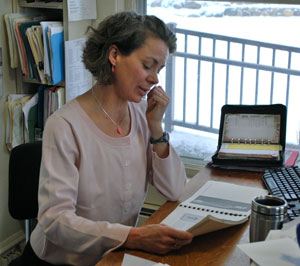
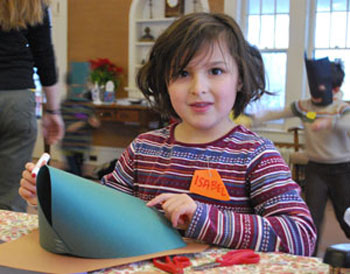
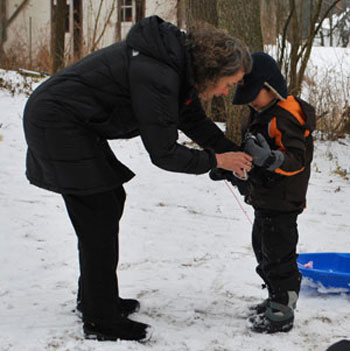

The LSNC is a truly unique community resource and is integral to making Ann Arbor such a special place to live and raise a family. We’ve been financial supporters for years and plan to continue. Because of it’s history as a “City department” it’s easy for the donor community to overlook this treasure. However, with budget cuts at the City and School levels, it’s more important than ever for the community to step up and support the LSNC with their dollars. It doesn’t take much, $50 and $100 contributions can make a difference when multiplied by thousands. Of course, larger contributions are welcome as well!
Kirsten has been an inspired leader, we will miss her!
Kirsten will be truly missed. She has worked very hard and leaves a strong program in place. I wish her the best of luck whatever she ends up doing.
Stew